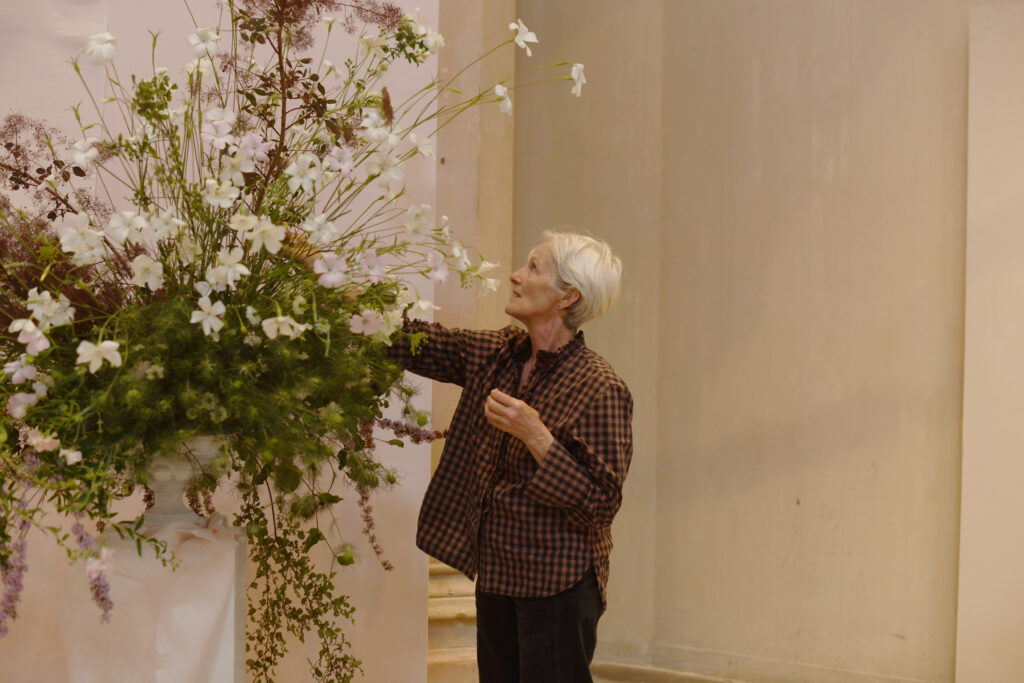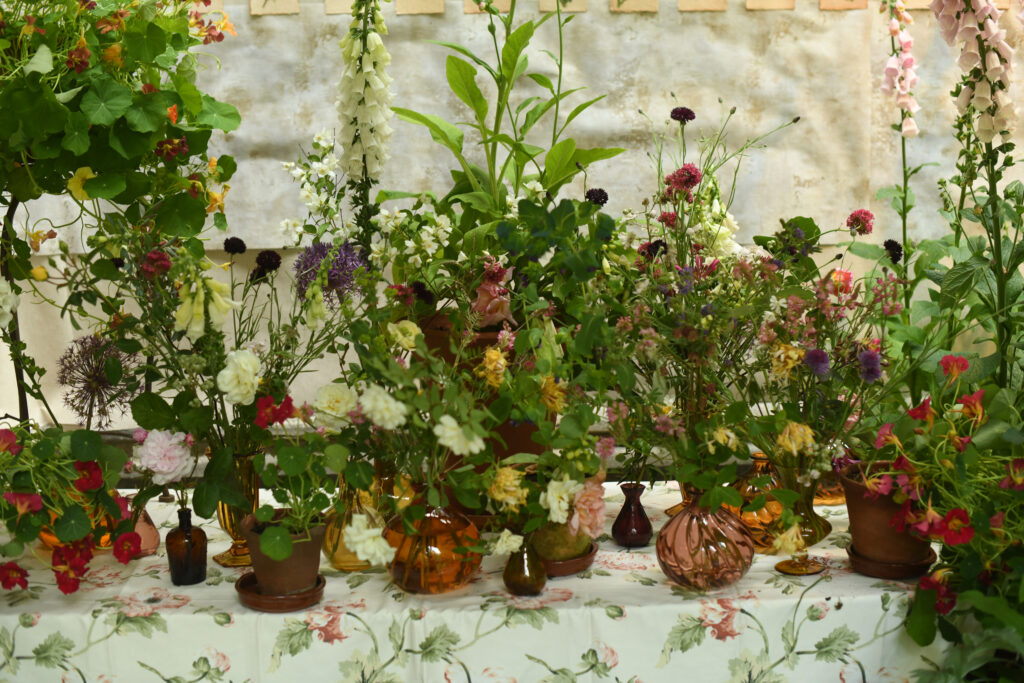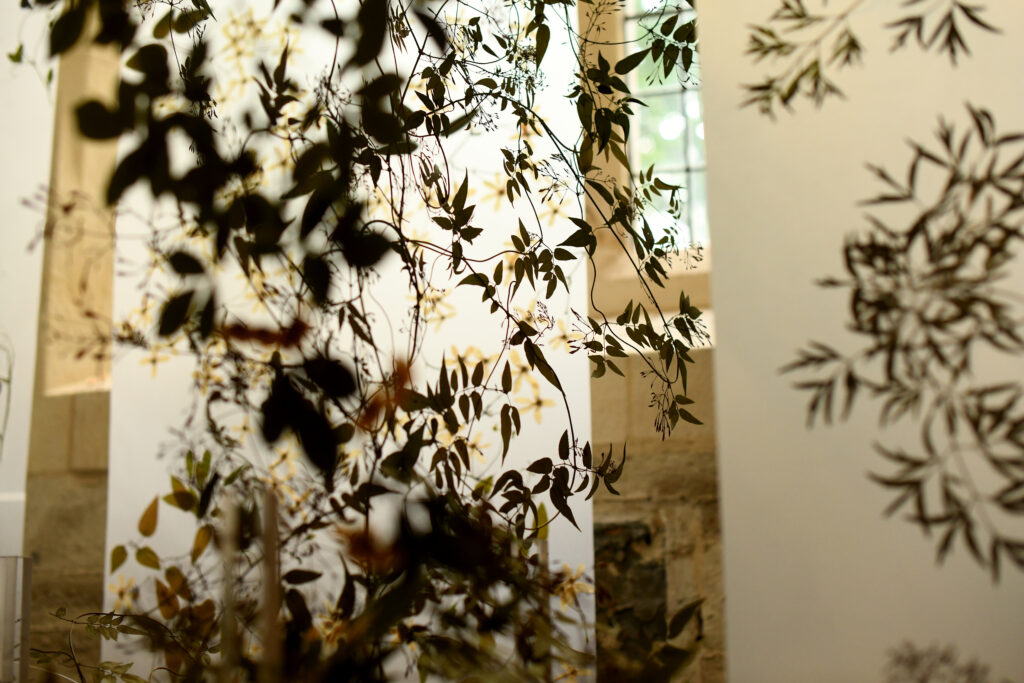Uniting florists, flower growers and flower lovers, British Flowers Week is a celebration of British-grown flowers and the immense creative talent in floral design to be found across the country.
Open until Sunday 8 June 2025, six floral designers are taking over the Garden Museum for a week of immersive floral installations, created using seasonal, British-grown flowers and sustainable methods. This year’s exhibiting designers are Arthur Parkinson, Leigh Chappell, Palais London, Rollo Skinner, Wild at Heart, and Yeon Hee Lee, selected to represent the diverse range of styles blossoming in floral design across the country.
Take a closer look at the installations and discover the florists’ inspirations in their own words:
Leigh Chappell

I grew up on the Gower coast, surrounded by wildflowers, and have always loved them. I began my working life as an illustrator but was torn between drawing flowers and arranging them. After some years in graphic design, I finally switched to floral design.


Cecil Beaton had a deep affection for flowers, which often appeared in his photographic portraits and personal life. I’m inspired by his dramatic portraits – some with rich, theatrical backdrops of drapes and florals, others strikingly simple, using paper for texture. Both approaches focus on subject. As an artist and designer, Beaton was truly ahead of his time.


My installation is intended as a floral portrait in which flowers are the subject – an ode to British flowers! Garden blooms have so much character – twisty stems, gorgeous colours and unforgettable scent. There’s an antique cast iron urn on a plinth filled with these flowers, in front of a large canvas backdrop in soft tones using water-based paint. To reference Beaton’s use of texture, I folded crepe paper around the base of the arrangement. The canvas and paper will be reused for future work. All flowers were sourced from local growers and will be composted when the event is over.
Arthur Parkinson: A Party for Pollinators

I’ve tried to cross what the essence of what my garden is with my style of arranging flowers, which is wild but simple and a continued passion for choosing varieties of flowers and organic gardening habits that nurture nature. I like to plonk cut or foraged flowers into my collection of vintage glass vases with little fuss but with hopefully a dramatic, en masse, millefleur effect. This is thanks to the vases individual shape or its weight in it being able to support either a single stem or a jumbled posy.


The living pots here represent a garden that is welcoming to both songbirds and pollinating insects which continue to face concerning declines. The honeysuckles have been grown through the woven stems of foraged birch. These come together to create a hedge, hedges are vital to give sanctuary to many beloved bird species.

A lot of the plants, I’ve grown in my garden and thankfully I have a kind neighbour who has let me use their greenhouse to help get the nasturtiums especially into flower. Towers of nectar rich ‘Suttons Apricot’ foxgloves are reminiscent of Beatrix Potters illustrations that I admired as a child and still find inspiring today as a gardener who craves the animation that animals give gardens. Now is a great time to be sowing the seeds of foxgloves for flowering next year, no flower is more beloved of the wild bumble bee. I have picked cut flowers from both my own garden and a nearby, esteemed Cotswold farmhouse garden that is Oxleaze barn. The living roses are ‘Tottering By Gently’ and Mutablis.

The backdrop and tablecloths to my floral jamboree are various vintage fabrics, all found as second-hand pieces. They have been joined with pressed viola flowers and illustrations of British butterflies taken from old books.
Palais: Leaf. Block.
An installation by Emma Weaver and her studio, Palais

Playful, immersive, and a little bit surreal, Leaf. Block. explores the joy and complexity of taste as it plays out in British gardens and public space. Taking inspiration from the everyday visual language of municipal planting and suburban front gardens, familiar motifs are reimagined through bold colour and sculptural composition.

The space is transformed through an architectural intervention of concrete blocks—once a staple of post-war housing and now a quietly iconic design. Arranged into an abstract form and planted with bright pelargoniums and wild stinging nettles, the installation plays with oppositions: wild and controlled, private and public, sincere and kitsch.
By referencing recurring tropes—like the bedding plant and the ornamental garden wall—as cultural “memes,” Leaf. Block. considers how aesthetic ideas spread, settle, and evolve. Rather than judging these forms, the work celebrates their persistence and encourages a closer consideration of what we often overlook.

Washed in a vivid red light, the entire scene is transformed into a strange and cinematic environment. Filtering out natural light flattens texture and obscures material, creating a charged and dreamlike atmosphere. This use of colour nods to the theatrical excess of photographer and designer Cecil Beaton, whose close friend Diana Vreeland—the legendary fashion editor and cultural commentator—declared that “red is the great clarifier.”


Wit and provocation are recurring touchpoints in Emma’s practice, which draws from a postmodern philosophy of embracing complexity, contradiction, and the visual language of the everyday. These ideas offer a framework for celebrating the strange beauty found in the most familiar things.
Leaf. Block. embraces this spirit—an affection for ordinary ornament, layered meaning, and irreverent fun. The work is as much about visual delight as it is about critical thinking. It invites visitors to slow down, to laugh, to wonder—and maybe to rethink what it means to have “good taste.”
Rollo Skinner: Flowers Will Take You Where you Need to Go

Curiosity is never frivolous. It illuminates the way to bright, unexpected, and glorious places.
When I began to explore the idea of changing my life, one thought kept coming back to me: flowers. I’d been dreaming of them, but couldn’t figure out how something so seemingly light-hearted could become a serious direction. I had a conversation with an artist friend who spoke these words: ‘Flowers Will Take You Where you Need to Go’. That was all I needed to hear – and so, my whole life changed.

To pay homage to Cecil Beaton’s vast array of limitless creative talents, I’ve created this painted hot-air balloon, as if lifting off, up, up and away, above the magnificent cloud topiary at Reddish House, his beloved Wiltshire home. Soaring on the fiery hues of the flowers, with the cooler plants to reflect the tranquility of the water meadow at Reddish – a vision in true theatrical Beaton style.

The balloon itself is created from stretched artist canvas, around a wooden frame, constructed by local craftsmen, Sean and Matt. I hand-painted silhouettes of my favourite West Country wildflowers and plants – how many can you name? The basket is made from woven willow garden fencing with trailing ivy garlands serving as its ropes. The plants were grown from seed at home or sourced from local suppliers and will eventually find a happy home back in the Dorset woods.


The design feels almost reminiscent of a large Japanese lantern, inspired partly by Beaton’s fascination with Japan. The piece stands as a celebration of the importance of adventure, play – and above all, following your curiosity!
Wild at Heart: Beaton’s Holy Spring

Our installation draws from Cecil Beaton’s mastery of theatrical photography and illusion. We’ve created a contemporary interpretation of ancient holy springs; sacred water sources venerated for thousands of years. The piece captures Beaton’s flair for vignettes, combining glimmering floral fountains on pedestals with touches of silver leaf that cascade into pools of lush greenery studded with jewel-like blooms.

Each floral element is water-sustained using chicken wire structures and decorative bowls, ensuring freshness throughout the exhibition. The verdant pools are formed with living plants, creating a dynamic installation that evolves subtly each day. Our commitment to sustainability guided every choice. All materials are reusable or compostable, with zero floral foam. Living plants will continue their lifecycle in our studio garden or recycled using COM:POST after the exhibition.


We proudly showcase locally grown British flowers, sourced from independent growers and our Creative Director’s allotment in the heart of Battersea. This approach celebrates British-grown flowers while reducing transportation emissions.
The holy spring represents renewal and the sacred relationship between water and plant life. Beaton’s influence appears in the theatrical presentation and careful composition, inviting viewers to discover beauty from multiple perspectives.
Please circle the installation to experience its changing composition from different angles. Notice how light plays across the silver leaf and water surfaces throughout the day, creating an ever-changing tableau that Beaton himself might have photographed.
Yeon Hee Lee: Through Blooms and Time

The first time I came to London, while I was walking around the town, I never felt bored because I could enjoy seeing all the beautiful trees and blooms growing in the neighborhood gardens. I couldn’t stop taking so many pictures; even ordinary ivy overflowing from the wall looked beautiful. Each garden was so different, with its own character.

I still remember my first garden party in midsummer at my friend’s house, where I met many lovely people and shared stories with them. Day trips to gardens with my friend on sunny days, wandering through gardens bursting with flowers, often made us lose track of time. Sometimes we were caught in the rain, but we even enjoyed seeing the reflections of the garden in the puddles after the shower. I treasure those times in my memory.
This installation represents my imaginary garden, as it reflects what my garden might look like if I could finally have one of my own one day. At the moment, I am having so much fun in my tiny balcony, which is my comfort zone and helps me relax no matter what difficulties I might face. It also makes me truly appreciate each stem of flower, as I’ve come to better understand how much effort is required for them to grow.

The pressed flowers in this installation come from many different English growers, with whom I enjoy talking about our shared love for flowers. Sometimes, I traveled over an hour by train to collect a precious bucket of blooms—but I never minded. Many flowers also come from the gardens of my friends who always support me and generously let me cut interesting things from their spaces. Additionally, some are foraged or grown on my tiny balcony.
I also pressed a lot of flowers after the events so that I did not waste them when they were still good to use.

I pressed flowers all year round, simply loving to watch how they retained their beauty after pressing. Surprisingly, when I checked them after many weeks and months, each one reminded me of the memories of that time: where I got them, what the weather was like that day—almost like reading a diary.

Pressed flowers are very fragile and flat, yet each holds its own quiet character. When they are connected to one another, they seem to come back to life with unexpected movement, texture and shape. Through this work, I hope the light and shadows of these pressed flowers will gently expand into the surrounding space.
